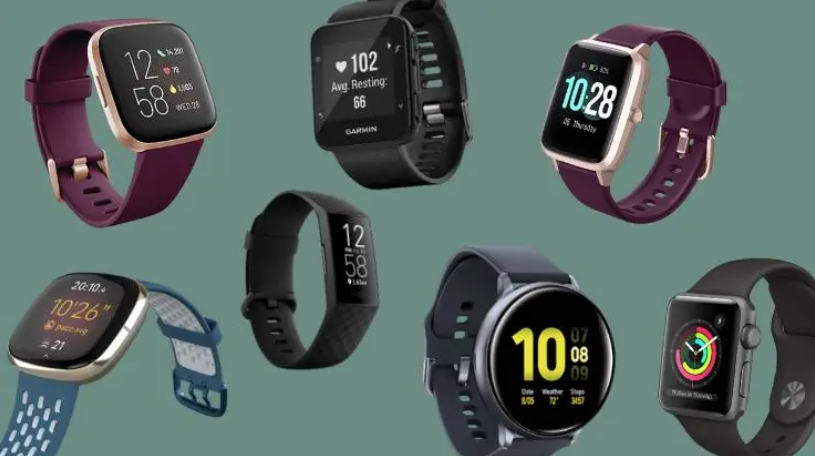Many users were enthralled by the prospect of wearing the James Bond-worthy, high-tech devices that could answer calls, respond to text messages, coordinate schedules, and browse the web when smartwatches first appeared on the tech scene. While those features remain crucial, the greatest smartwatches of today have evolved into little health centres. If you know someone who wears a fitness tracker, you’ve probably heard them say, “Hold on — I need to get my steps in,” or seen them walk laps around the workplace to meet a movement goal.
It may have appeared strange to you as an outsider in the world of high-tech fitness pedometers, but with the COVID-19 pandemic keeping us indoors and making regular workout routines more difficult or at least less accessible, you may be finally feeling the urge to get in on the bandwagon. After all, health trackers are an excellent way to hold yourself responsible to your movement objectives, keep track of your sleeping habits, and much more. We’ve taken the first step by highlighting the finest of the best smartwatches so you can select one that suits your needs.
Versa 2 by Fitbit
The Fitbit Versa 2 is a fitness smartwatch, unlike other Fitbits, thus it may easily fill the Apple Watch hole in your life. On the fitness front, we like the Versa 2’s 15+ goal-based activities (along with real-time stats) and customizable guided breathing exercises. If you’re already wedded to a non-Fitbit smartwatch, the Versa 2 is clearly a premium health and fitness tracker first and a smartwatch second, so you might want to reconsider.

The Versa 2 includes Amazon’s virtual assistant, Alexa, as well as additional in-depth sleep tools and a built-in GPS. Users can also stream music from Spotify, check hundreds of applications (from the weather forecast to Strava), and text using voice replies. If you’re interested in smartwatches, you’ll see that these are some of the most sought-after characteristics for the average user. The Versa 2 is an excellent pick if you’re looking for a smartwatch primarily for fitness purposes but also want a couple nice added features.
Fitbit Sense is a wearable computer.
The Fitbit Sense will take the place of the Fitbit Ionic in September 2020. And it did so in grand style – just take a look at that gorgeous full-color display! Without a question, the Sense can replace your current smartwatch, and for many of us, reducing the amount of devices we use on a daily basis can be a huge benefit. Unlike previous models, this one allows you various options for choosing a virtual assistant: Google Assistant and Amazon’s Alexa are both available to assist.

The Sense is jam-packed with cutting-edge health features. It can monitor your skin temperature, is ECG compatible, has an in-depth sleep tracker, and allows you to record more than 20 goal-based activities (and get those real-time stats). This device can do practically whatever your smartphone can do, from Fitbit Pay and text-to-speech to Spotify and Uber access. Bonus: The Sense’s battery lasts around six days on a single charge, and it may last a full 24 hours after only 12 minutes of charging time.
Apple Watch Series 3 is the third generation of the Apple Watch.
Without a question, Apple’s smartwatch response has become a catchphrase for all smartwatches, much like Google and Zoom have become catchphrases for search engines and video-conferencing platforms, respectively. The Apple Watch Series 3 is a fantastic, top-of-the-line smartwatch, but it falls short in a few areas that may be most crucial to anyone seeking for a fitness tracker.

In many ways, an Apple Watch can be used in place of your iPhone. If you don’t want to take out your phone, you can use the stunning retina display to access most apps; it also stores music, podcasts, and audiobooks and serves as a superb GPS. The Apple Watch is swimproof, has an optical heart sensor, and Emergency SOS functions, as well as the ability to track your activity trends. It can be programmed to work with your training programs or you can look at your “fitness rings,” which fill up based on your activity level, steps taken, and other factors.
What are the disadvantages? Although the Apple Watch’s pricing tiers have just been reduced, it may still be too expensive for some users. The watch’s major flaw, though, is its battery life: This device, unlike a Fitbit, requires charging at the end of each day of use, making sleep monitoring and other capabilities difficult to utilize.
Samsung Galaxy Watch Active2 is a smartwatch by Samsung.
It’s difficult to match the praise that critics have given the Samsung Galaxy series smartwatches when it comes to outstanding smartwatches. The new Samsung Galaxy Watch Active2 is compatible with both Android and iOS phones (cough cough, some firms can’t play along with others) and can last for up to five days on a single charge. However, the watch’s long-lasting battery isn’t its sole benefit. In fact, Samsung is where top-notch craftsmanship meets a terrific price point, and while it isn’t a “cheap” watch, it is the ideal compromise for those wishing to make a long-term commitment.

The Active2 is lightweight and comfortable, and it’s loaded with cutting-edge workout functions. You’ll stay on track and get the most out of every mile as you work toward your fitness goals thanks to the watch’s smart sensors. Are you concerned about maintaining your heart and mind in good shape, as well as the rest of your body? The device is designed to detect high and low heart rates and provides you with essential, detailed information about your night’s sleep as well as help you keep track of your stress levels. Bottom line: Get all the bells and whistles – a fully working smartwatch — without sacrificing battery life, Fitbit-like features, or your cash.
Charge 4 by Fitbit
The Fitbit Charge 4, dubbed Fitbit’s “most advanced” tracker, is, all things considered, our preferred option. While it may not have all of the bells and whistles that Fitbit’s smartwatches (or smartwatches in general) have, it does contain a variety of features that can help you achieve your health and fitness objectives. Unlike many other Fitbits, the Charge 4 has a built-in GPS, which lets enthusiastic runners and cyclists to more accurately account for their pace and distance.

Is there any other benefit? This device has a seven-day battery life, which means you can collect a week’s worth of data from a single charge. It also has 24/7 heart-rate tracking and in-depth sleep tracking. Although it lacks the software capabilities of a true smartwatch, the Charge 4 does support “tap to pay” and provides users with weather, timer, and calendar apps. We also like the Charge 4’s simple, unobtrusive design and easy-to-read display.
Forerunner 35 by Garmin
When you hear the term Garmin, you’re probably thinking about the first generation of successful GPS gadgets. One of the nicest aspects of the Garmin Forerunner 35 smartwatch is its simple GPS, which records how far, how fast, and where you run. Surprisingly, not every Fitbit model comes with a (good) GPS, so if you need one, Garmin might be the way to go.

The Forerunner model also includes a slew of additional desirable features. When coupled with your smartphone, it tracks your heart rate throughout the day and night, allows for Smart notifications, gives live tracking and music controls, and delivers all-day activity tracking, including steps, calories, and movement reminders. Garmin Connect automatically uploads your data to the brand’s free online fitness community, which conducts challenges, provides insights, and lets you and your friends to share your progress if you need a little extra help meeting your fitness objectives.
Smart Watch by Letsfit
Are you looking for something that won’t cost you a fortune? The Letsfit Smart Watch, which costs less than $50, is one of the best cheap smartwatches available. Although the smartwatch’s functionality are restricted, the necessities, such as receiving SMS and social media notifications, are all included. This device is also well worth the money, with long battery life, a wide range of smartphone compatibility, and the brand’s own Letsfit app.

In terms of daily tracking, you can see your progress in three sport modes: running, walking, and cycling, as well as gain information on your heart rate, calories burned, and distance traveled. While the sleep tracking isn’t as advanced as Fitbit models, you can still see your sleeping patterns and see what needs to be improved. What’s another fantastic feature? The built-in breathing guide program guides you through a series of stress-relieving activities. In short, both you and your wallet will be at ease.



